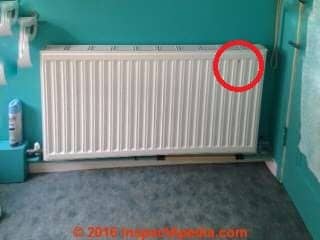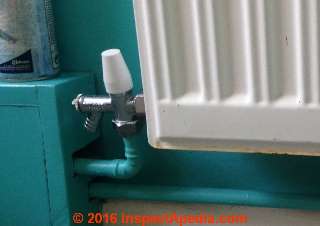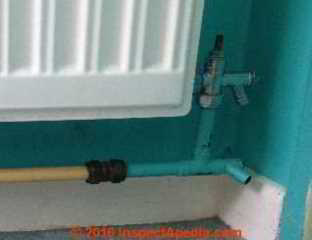 Night Storage Heaters & Heat Sink Radiators
Night Storage Heaters & Heat Sink Radiators
Supplemental electric heat vs heat dump radiators on hot water systems
- POST a QUESTION or COMMENT about electric night storage heaters or heat sink or heat dump radiators
Night storage heaters & heat dumping radiators:
This article first describes night storage heaters, including the definition of a night storage heater, where they are typically used, and recommendations for making the most effective use of a night storage heater.
Second we describe heat dumping radiators, also referred to as heat sink radiators or heat leak radiators used with hot water heating systems to provide water circulation and temperature control.
InspectAPedia tolerates no conflicts of interest. We have no relationship with advertisers, products, or services discussed at this website.
- Daniel Friedman, Publisher/Editor/Author - See WHO ARE WE?
Night Storage Heater & Heat Sink Radiator Installation & Operation
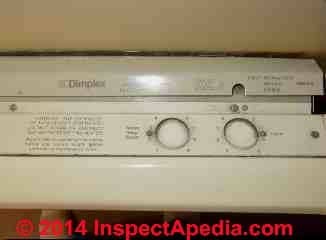 Although they are quite different in operation, night storage heaters and heat sink radiators are steel appliances that work to store and release heat in high-efficiency energy-conserving heating or hot water heating system designs. Here we describe and compare the operation of these two approaches to heating buildings and hot water.
Although they are quite different in operation, night storage heaters and heat sink radiators are steel appliances that work to store and release heat in high-efficiency energy-conserving heating or hot water heating system designs. Here we describe and compare the operation of these two approaches to heating buildings and hot water.
Our photo shows the controls on a Dimplex™ electric Night Storage heater installed in campus housing, University of Canterbury, in Christchurch, New Zealand.
[Click to enlarge any image]
Article Contents
Definition of a Night Storage Heater
Night storage heaters combine an energy source (electricity at off-peak rates) and a thermal mass (such as heavy bricks or cast iron) to store energy in the form of heat so that that same heat can be directed into the occupied building space when needed.
Storage heaters are designed and controlled to take advantage of off peak electrical rates to store heat for later use. These heaters are typically used in climates that are mild enough that larger, high-capacity central heating is not required. The Dimplex storage heater illustrated here is installed in a home in Christchurch, New Zealand. We estimate that this unit has been in service since 1981.
In Scotland and other U.K. countries similar night storage heaters, also made of steel, are connected to hot water heating systems and form heat sinks that store unneeded heat. An example of a steel heat sink radiator on a hot water system heated by a biomass boiler is at LEAKS in STEEL RADIATORS.
How does a Night Storage Heater Work?
The night storage heater is charged (heat is stored in its thermal mass) usually at night during off-peak hours, a period when electric utility rates are lower than during daytime hours. For this reason, the heater will feel hottest in the morning - it has been charging or absorbing heat provided by electricity during the night.
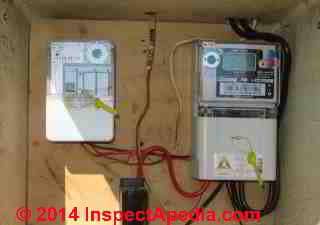 During the day, as heat is transferred from the storage heater to the building's occupied space, the heater slowly cools off. If the heat output during this period is not sufficient the occupants can increase the heat output from the unit by adjusting its output control.
During the day, as heat is transferred from the storage heater to the building's occupied space, the heater slowly cools off. If the heat output during this period is not sufficient the occupants can increase the heat output from the unit by adjusting its output control.
In order to take advantage of off- peak electrical rates, the night storage heater will be supplied electricity through a separate electric meter and wiring circuit used only for the heater.
Our photo (left) shows the separate meter for the storage heater - the left-most meter in the enclosure. The separate circuit for the night storage heater is labeled "night storage" and can be seen as a vertical wire between the two electric meters.
[Click to enlarge any image]
Typically the charging circuit will automatically switch on during off-peak hours and switch itself off during hours of peak electricity demand. At the end of the off-peak rate charging period after the charging circuit has switched off, the heater continues to release heat (from its stored thermal mass) over the course of the day.
Supplemental heating might be needed when cold weather combined with a high building heat loss rate may exceed the output capacity of the storage heater. This supplemental heat may be provided by other heat sources (e.g. by a pellet stove or by other electric heaters that operate during more costly peak rate times).
Night storage heaters give out some heat even when the heater is ‘charging’ during the night, thus assuring that the building receives some heat during those hours.
Recommendations for Use of Night Storage Heaters
The following guidance on using a night storage electric heater is adapted from information provided by the University of Canterbury housing department, Christchurch, New Zealand.
Watch out: prevent contact with a night storage heater surface by children, elderly or frail individuals: the surface of an electric night storage heater can be quit hot.
In New Zealand the surface temperature of a night storage heater must meet the requirements of AS3103 that addresses the safety-covering requirements of electric heating appliances. In Europe, the night storage heater surface temperatures meet a similar standard, quoted from Dimplex:
The surface temperatures of this heater are within the requirements of EN60335-2-61, the European Standard covering the safety requirements for Electric Storage Heaters, and momentary contact with any part of the heater should not cause injury.
However, in order to be effective, heaters of any type do get hot, especially around the air outlet grille. - Dimplex XLN / XLSN Operating Manual
At the temperatures specified by these two standards, momentary contact with the heater surface should not cause injury but the heater surface will indeed feel quite hot to the touch, especially around the air outlet grille on the heater face or on some models its top.
How to Set the Night Storage Heater Controls
Typical night storage heaters include two occupant-adjustable control knobs.
Temperature input (right hand knob on the night storage heater shown above): this knob is set to its highest position (9) to obtain the maximum heat into (and subsequently out of) the storage heater. In cool but not very cold weather, when less heat will be required, you can set this control to a lower number. Note that the University has removed the actual control knobs on this heater, leaving this unit set at fixed (and undetermined) settings.
Dimplex recommends the following Input Knob settings based on weather conditions:
- Very cold weather: set the knob to 8 - 9
- Cold weather: set the knob at 4 - 8
- Mild weather: set the control knob at 2-4
Temperature boost (left hand knob on the night storage heater shown at above left).
Dimplex explains the settings of the temperature boost control as follows:
- No temperature boost: set to 1
- Late temperature boost: set to 2
- Early temperature boost: set to 9
The University instructs occupants to set to this control as follows:
- (1) the temperature boost is at its lowest position. This is a recommended position for daytime.
When set to (1) the heater's damper is closed and the unit delivers heat only by radiation from its surfaces and by natural air convection around the exterior surfaces of the unit.
- (9) When set to a higher number (9 is maximum) the heat output from the unit is at its greatest.
To obtain additional heat output from the storage heater, the temperature boost knob can be set to a higher or even its highest number. Normally the temperature boost is set up to a higher number when occupants are active in the building and is returned to its lowest setting (1) when occupants retire to bed for the night. This approach helps assure that the night storage heater will continue to deliver heat to the building interior (though at a lower rate) throughout the night.
When you open the damper (increase the temperature boost of the night storage heater) the open damper increases the air-flow through the unit, releasing heat more rapidly into the occupied space.
Watch out: if you leave the temperature boost on continuously (that is, during the day when less heat should be required), the heater will have less heat stored for release during colder night time periods.
Watch out: The controls an a wall-mounted night storage heater are (or should be) placed on the unit's top edge where they are visible and accessible by an adult but where they will not be readily apparent (and tempting) to toddlers who like to twist knobs.
Night Storage Heater Mounting
Watch out: because a night storage heater is heavy (earlier we mentioned the need for thermal mass in the form of bricks, cast iron or other heat storage media), it must be securely mounted to the building wall, preferably to wall studs or using suitable wall mounting hardware. Don't remove or disassemble a night storage heater from its installed position.
The night storage heater shown here is installed with its feet resting on the (carpeted) floor, and with an 8-inch clearance to combustibles at its left and right sides and also at its top surface.
- Do not install this type of electric heater below an electrical receptacle (a " fixed electric socket outlet")
- Do not install a night storage electric heater under windows (or in other locations) where curtains may contact the heater
- Do not place objects in contact with the heater
- For the Dimplex Model XL12N / XL 18N / XL 24N maintain 3" (75mm) between the heater sides and any adjacent surfaces such as a wall or furniture. These also apply to Dimplex storage heater models XLS12N/18N/24N Automatic.
- For the Dimplex Model XX maintain 10" (250mm) between the heater top surface and any projecting overhang
- The heater's feet are designed to maintain suitable clearance from wall skirting or baseboard trim, but the company emphasizes that
To avoid obstructing the airflow to the rear of the heater, the following must be strictly adhered-to- For skirtings (baseboard floor trim) higher than 4" (100 mm) it is necessary to position the heater with screws attached to the alternative fixing slots to the front
- For skirtings higher than 6" (150 mm ) you must reduce the height of the skirting trim to 6" over the entire length [width along the wall] to 6" plus 1" (25mm) at either end of the heater.
- Watch out: These instructions are given as an example of installation of an electric storage heater. Depending on the storage heater brand and model other clearance distances and other installation and safety instructions may be specified. Be sure to check with your unit's manufacturer.
Night Storage Heater Cleaning
Simple dry dust cloth wiping of the heater exterior surface is recommended during the heating season if dust is accumulating there
In warm weather or when the heater is off completely, damp-wipe the heater's exterior surfaces to clean them. Do not use abrasive cleansers and do not use furniture polish on the heater surfaces.
Hydronic Heat Sink / Heat Dump Radiators on Hot Water Systems
The steel radiatior shown above is the heat sink radiator for a hot water heating system in Scotland that uses a biomass boiler that burns wood pellets. The radiatior in this particular system is connected to a lagged (insulated) hot water storage cylinder or tank. Other radiators in the home are controlled by thermostatic radiator valves.
This one is not, and cannot be controlled by a valve, as we explain below.
A leak at this heat sink radiator radiator (circled in red) is discussed
Heat sink radiators are used with hot water cylinder systems and typically with an energy-efficient heat source that one wants to keep in operation for extended periods of time, typically with solid fuel heating boilers such as wood stoves or pellet stoves.
A heat sink radiator is an essential part of the system to which it is attached as the radiator provides the source of both circulation of hot water through the system and a temperature control to avoid overheating of the system.
How a Heat Dumping Radiator Uses Natural Convection to Circulate Hot Water
In the U.K., traditional solid-fuel hot water heating systems use a gravity-circulated domestic hot water piping circuit that circulates hot water from the wood stove, coal, peat, or pellet stove to a large hot water storage cylinder using a circulating pump. The system that we illustrate here uses a heat sink radiator to cause hot water to circulate by convection.
The hot water in these traditional heating systems circulates by "gravity" or for more technically-minded readers, by convection. That means that we take advantage of the difference in density between hot water and less hot (or cold) water (cold is heavier) to cause water to circulate through a piping system.
Because unlike the domestic hot water cylinder (hot water tank) the heat sink radiator continuously releases heat into the occupied space of the building some soruces call a heat sink radiator a heat-leak radiator or a heat dump radiator.
Because it is always losing some heat into the room where it is installed, a heat sink or heat dump radiator will always be at a lower temperature than the hot water flowing through it.
This lower temperature across the radiator cause hot water to circulate through the water heating system by convection. Larger heat sink radiators or a heat sink radiator installed in a colder location will cause faster water circulation through the system.
U.K. experts (cited below) note that the radiating capacity of the radiator (basically it's size) should be at least 10% of the KW output of the maximum heat output of the source heat - in this case a biomass wood-pellet stove. Some designs use 20%.
Heat Sink Radiators Allow Solid Fuel Heaters to Avoid Shutting Off
By keeping the heating system water from becoming too hot the heat sink radiator allows the wood-pellet stove to keep operating without having to shut off due to excessive temperatures in the system. Without this feature the room where the pellet stove itself is located could become chilly when the stove shuts down because the thermostatically controlled hot water radiators in other rooms in the building are too hot.
The heat dumping radiator also prevents water in the heating system from boiling and avoids sending scalding water to the building fixture taps. These radiators are also used with cookers that also produce heat for storage including heaters produced by Aga and Rayburn.
Watch out: proper piping and venting to the atmosphere and proper location of (or prohibition of) control valves are essential for the safe operation of these heating systems.
Below are additional details of the radiator piping at this installation. While you see what look like control valves at the ends of this radiator, they're not.
They're safety devices. No control valves can be installed at the heat sink radiator since it must be always-on whenever the heat source (wood pellet stove for example) is on.
Notice rust traces along the bottom of the heater.
Typical locations for heat sink radiators are in rooms where the heat-always-on operation is not an issue, cold locations such as landings or locations where you like a bit of extra heat such as bathrooms.
Night Storage Heater & Heat Sink Radiator Sources & Information
- AGA Range Cookers, Website: http://www.agaliving.com/, AGA UK, Tel: 0845 712 5207, AGA Republic of Ireland, Tel: 01 663 6166 and AGA International Tel: +44 (0)115 946 6106 - also see Rayburn below.
- Dimplex Corporation, Electric Fires and Storage Heaters allowing heating with off-peak electricity usage, New Zealand: Tel: +64 9 274 8265, website: http://www.dimplex.co.nz
- Dimplex Storage Heaters, GDC Group Ltd Millbrook House Grange Drive Hedge End Southampton SO30 2DF, Dimplex UK Limited, Millbrook House, Grange Drive, Hedge End, Southampton, SO30 2DF, U.K. information: Tel: 0844 879 3588, Email: customer.services@gdcgroup.co.uk Website: www.dimplex.co.uk/support
- "Conventional Gravity Hot Water and Pumped Radiator System - Wood Fired Heating System Designs", Blakemore & Chell, Stockmeadows Farm, Meerbrook, Nr Leek, Staffordshire, ST13 8ST Tel: 01538 382387 UK, Website: retrieved 2016/06/22, original source: http://www.blakemoreandchell.co.uk/conventional-gravity-hot-water-and-pumped-radiator-system/
- "Heat Sink Radiator", Stovefitter's Manual, 213 Station Road,
Deganwy
Conwy
LL319EX, UK, Tel: 01 492 53 5852 or
The Wood Stove Hut Ivy St Colwyn Bay LL298GA 01492 535852, UK Website: www.stovefittersmanual.com.uk, retrieved 2016/06/22, original source: http://www.stovefittersmanual.co.uk/articles/heat-sink-radiator/ - McNeil, Dan, "Renewable Energy: Heat-Dump Radiators Off a Gravity Circuit", Green Building Forum, (October 2008), Website: http://www.greenbuildingforum.co.uk/ , retrieved 2016/06/22, original source: retrieved 2016/06/22,
- Rayburn Solid Fuel Boilers, Range Cookers, Central Heating Systems, AGA Rayburn Head Office, AGA, Station Road, Ketley, Telford, Shropshire TF1 5AQ, Republic of Ireland Sales: 1850 302 502 Northern Ireland Sales: 028 8772 2195 International Sales: +44 (0) 115 946 6106 - Website: http://www.rayburn-web.co.uk/ [Note: Rayburn is a trading name of AGA Rangemaster Limited Registered in England & Wales
...
Continue reading at PORTABLE ELECTRIC HEATER SAFETY or select a topic from the closely-related articles below, or see the complete ARTICLE INDEX.
Or see these
Recommended Articles
- BLOCKBED RADIANT FLOORS - SOLAR DESIGN - an alternative design approach to storing heat
- ELECTRIC HEAT - home
- ELECTRICAL POWER SWITCH FOR HEAT
- LEAKS in STEEL RADIATORS
- WALL CONVECTORS HVAC
Suggested citation for this web page
NIGHT STORAGE HEATERS & HEAT SINK RADIATORS at InspectApedia.com - online encyclopedia of building & environmental inspection, testing, diagnosis, repair, & problem prevention advice.
Or see this
INDEX to RELATED ARTICLES: ARTICLE INDEX to HEATING SYSTEMS
Or use the SEARCH BOX found below to Ask a Question or Search InspectApedia
Or see
INDEX to RELATED ARTICLES: ARTICLE INDEX to HEATING RADIATORS
Or use the SEARCH BOX found below to Ask a Question or Search InspectApedia
Ask a Question or Search InspectApedia
Try the search box just below, or if you prefer, post a question or comment in the Comments box below and we will respond promptly.
Search the InspectApedia website
Note: appearance of your Comment below may be delayed: if your comment contains an image, photograph, web link, or text that looks to the software as if it might be a web link, your posting will appear after it has been approved by a moderator. Apologies for the delay.
Only one image can be added per comment but you can post as many comments, and therefore images, as you like.
You will not receive a notification when a response to your question has been posted.
Please bookmark this page to make it easy for you to check back for our response.
IF above you see "Comment Form is loading comments..." then COMMENT BOX - countable.ca / bawkbox.com IS NOT WORKING.
In any case you are welcome to send an email directly to us at InspectApedia.com at editor@inspectApedia.com
We'll reply to you directly. Please help us help you by noting, in your email, the URL of the InspectApedia page where you wanted to comment.
Citations & References
In addition to any citations in the article above, a full list is available on request.
- University of Canterbury Housing Instructions Booklet, University of Canterbury, Christchurch, New Zealand, as observed 9/5/2014,
- Our recommended books about building & mechanical systems design, inspection, problem diagnosis, and repair, and about indoor environment and IAQ testing, diagnosis, and cleanup are at the InspectAPedia Bookstore. Also see our Book Reviews - InspectAPedia.
- In addition to citations & references found in this article, see the research citations given at the end of the related articles found at our suggested
CONTINUE READING or RECOMMENDED ARTICLES.
- Carson, Dunlop & Associates Ltd., 120 Carlton Street Suite 407, Toronto ON M5A 4K2. Tel: (416) 964-9415 1-800-268-7070 Email: info@carsondunlop.com. Alan Carson is a past president of ASHI, the American Society of Home Inspectors.
Thanks to Alan Carson and Bob Dunlop, for permission for InspectAPedia to use text excerpts from The HOME REFERENCE BOOK - the Encyclopedia of Homes and to use illustrations from The ILLUSTRATED HOME .
Carson Dunlop Associates provides extensive home inspection education and report writing material. In gratitude we provide links to tsome Carson Dunlop Associates products and services.


